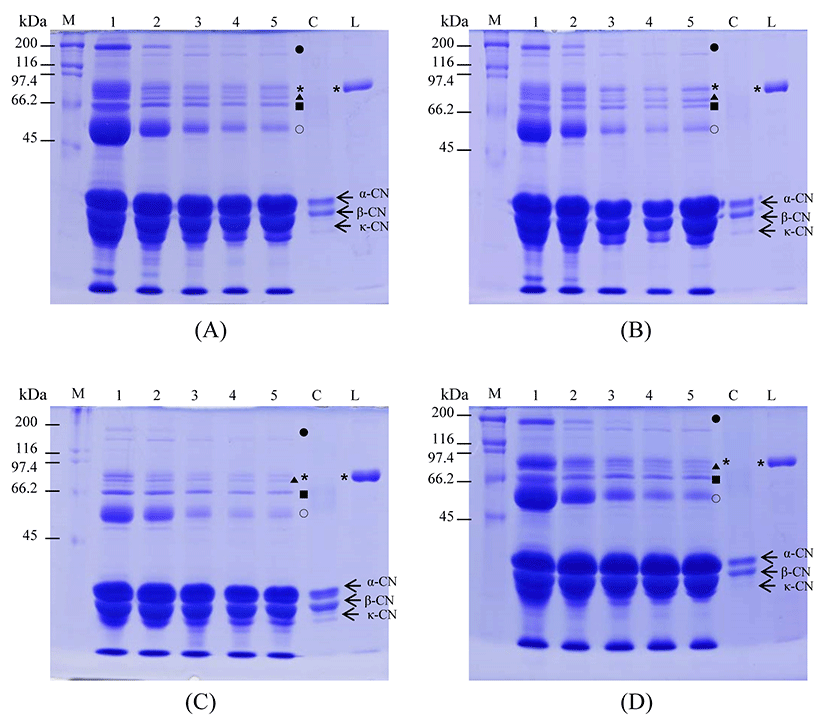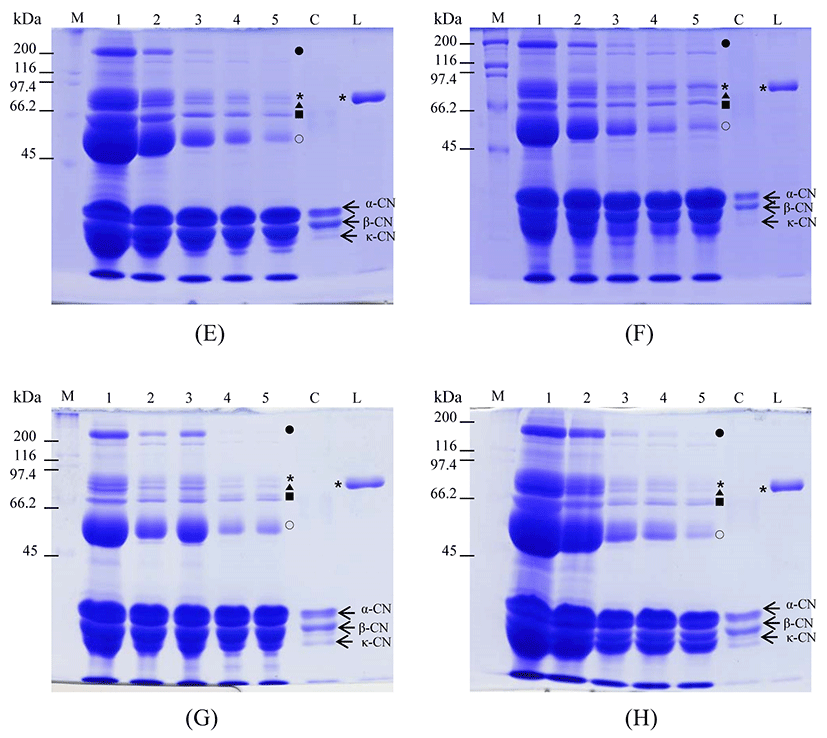서 론
유(milk)를 분비하는 대표적인 반추동물은 젖소, 양, 그리고 산양이 있으며, 대부분 인간이 음용하고 있다. 특히 유아는 모유의 대용으로서 많이 이용되고 있으며, 식용뿐만 아니라 감염방어, 신경안정 및 정신발달에 매우 중요한 역할을 하고 있다(Mohanty et al., 2016). 우유 단백질은 카세인(casein)과 훼이단백질(whey protein)로 대별된다. 카세인은 우유 단백질의 75∼85%를 차지하고, α-casein, β-casein 및 κ-casein으로 구성되어 있다. 한편, whey protein은 우유 단백질의 15∼25%를 차지하고, β-lactoglobulin, α-lactalbumin, bovine serum albumin, immunoglobulin, lactoferrin 등으로 구성되어 있다(Mohanty et al., 2016).
우유 성분의 조성은 분만 후, 비유기가 경과함과 더불어 변화한다. 이러한 유성분 조성의 변화는 비유기 초기에 현저하다. 분만 직후의 유를 초유(colostrum)라고 하는데, 초유에는 단백질 중 유청단백질의 함량이 상당히 높다(Parrish et al., 1950). 초유는 분만 후 3일 동안 유선세포에서 분비된다(Piot et al., 2004). 초유는 농도가 짙으며, 점도가 높고 황색을 띄고 있다. 초유는 단백질, 탄수화물, 지방, 비타민 및 미네랄이 풍부한 영양소로 구성되어 있다(Elfstrand et al., 2002; Uruakpa et al., 2002; Piot et al., 2004). 또한 영양분이 풍부할 뿐 아니라, 갓 태어난 새끼에게 개체 보존에 필요한 생장인자, 항균물질 및 면역물질 등의 생리활성 물질들이 많이 함유되어 있다(Pouliot and Gauthier, 2006). Uruakpa 등(2002) 등에 의하면 초유는 중요한 두 성장인자 transforming growth factor b(TGF-b)와 insulin-like growth factors 1 and 2(IGF-1, IGF-2)의 천연 자원이라고 서술하였다.
갓 태어난 송아지는 초유의 이행 항체에 의한 수동면역의 획득에 크게 의존하고 있다(Logan and Pearson, 1978; Lomba et al., 1978). 젖소 초유는 면역글로블린(IgG)이 풍부한데, 그 이유는 소를 비롯한 반추동물들은 모친과 태아 사이에 혈관이 직결되어 있지 않기 때문에 IgG는 태반을 통해서 태아에게 전달되지 않는다(Wallach, 1974). 대신 송아지들은 초유를 섭취하여 장에서 IgG를 흡수한다(Pakkanen and Aalto, 1997). 면역글로불린은 유즙의 면역성분 중에서는 가장 중요한 성분으로 되어 있으며, 그의 기능으로는 병원성 항원에 대하여 활성을 갖는 항체로서 직접 이들 항원의 장관점막에 감염을 일으키는 것을 방지한다(Butler, 1979). 따라서 초유는 자축에 있어서 영양원의 보급, 감염증을 방어하는 면역항체의 부여, 그리고 태변의 배세 등 매우 중요한 기능을 가지고 있다(Suzuki et al., 1977).
지금까지 젖소 초유의 연구는 생리활성물질의 정량(Masson and Heremans, 1971), 항균활성 측정(Erdei et al., 1994; Korhonen et al,, 1995; Naidu and Arnold, 1994) 및 유산균 성장촉진효과(Aparna and Salimath, 1999; Tacket et al., 1992) 및 비피도박테리아 생장 (Aparna and Salimath, 1999)에 관한 연구들이 보고되었다. 이와 같이 초유는 정상유보다 많은 생리적 기능을 가지고 있고, 특히 면역글로불린 및 락토페린 등과 같은 면역관련 성분이 다량 함유되어 있기 때문에, 자축의 면역기능을 유지하기 위해서는 초유 급여가 불가결로 있다. 초유의 조성과 물리적인 특성은 동물의 년령, 산차, 품종, 식이 그리고 질병과 같은 다양한 인자에 의해서 변화한다(Tsioulpas et al., 2007). 그러나 젖소 산차에 의한 초유의 성분변화에 대한 연구 논문은 미비한 실정이다. 따라서 본 연구는 젖소의 산차에 의한 분만 후, 5일간 초유의 단백질 변화를 SDS-PAGE(sodium dodecyl sulfate polyacrylamide gel electrophoresis)에 의해서 조사하였다.
재료 및 방법
전기영동에 사용된 30% acrylamide, Coomassie Brilliant Blue(CBB) R-250, 그리고 Urea는 TNT Research. Co., LTD.(Jeonju, Korea)의 것을 사용하였고, Tris, Sodium dodecyl sulfate(SDS), Ammonium persulfate(APS), Tetramethylethylenediamine(TEMED), Glycine, 그리고 Sodium chloride는 Amresco(Ohio, USA)의 것을 사용하였다. 2-Mercaptoethanol, Bromophenol Blue(BPB)는 Sigma(MO, USA)의 것을 사용하였으며, Glycerol, Acetic acid, 그리고 Methanol은 Daejung Chemicals & Metals Co., LTD(Korea)의 것을 사용하였다. Triton X-100은 Yakuri Pure Chemicals Co., LTD(Japan)를 사용하였다. 락토페린은 모리나가 유업으로부터 구입하였다(Zama, Japan). 우유 카세인은 Calbiochem(CA, USA)으로부터 구입하여 사용하였다. 락토페린과 카세인은 전기영동의 marker와는 별도로 표준단백질로 이용하였다.
각 산차에 의한 젖소 초유의 분만 후 1일부터 5일까지의 단백질 변화를 살펴보기 위해 SDS-PAGE를 시행하였다. 각 산차에 의해 준비된 분만 후 1일에서 5일까지의 젖소 초유를 멸균된 Milli Q water로 1/10 희석하였다. 희석한 sample들은 1×Sample buffer와 1:1의 비율로 혼합하였다. 혼합된 sample들은 100℃에서 5분간 열처리한 후 전기영동을 시행하였다. SDS-PAGE는 10% polyacrylamide gels로 Laemmli(1970)의 방법에 따라 수행하였다. 샘플은 각 well당 20 μL를 주입하였다. 한편, Maker는 high marker(CA, Bio-Rad)를 사용하였다. 영동이 끝난 gel은 Coomassie brilliant blue(CBB) R-250으로 염색하였다.
결과 및 고찰
본 연구는 산차별 젖소의 분만 직후부터 5일까지의 초유성분에 대한 변화를 조사하였다. Table 1은 보고된 주요 우유단백질과 분자량을 나타내었다. 면역글로불린은 SDS-PAGE에서는 heavy chain과 light chain으로 분리되는 것이 확인되었다(Anema, 2009). 이러한 분리는 전기영동 샘플처리 중 2-mercaptoethanol에 의해 절단된 것으로 사료된다. Fig. 1과 2는 각각 젖소 초산우(A), 2산(B), 3산(C), 4산(D)과 5산(E), 6산(F), 7산(G), 그리고 8산(H) 초유의 5일간 전기영동을 통한 단백질 변화를 나타낸 결과이다. 분만 후 전체적인 단백질 함량의 변화를 보면, 초일 대부분의 단백질이 많이 함유되어 있다가 시간이 지날수록 점점 감소하는 것을 보여주고 있다. 특히 면역과 감염 예방에 관련되어 있는 면역글로불린과 락토페린의 변화는 현저한 격차를 보여주었다. 면역글로불린(●부분)은 분자량 160 kDa으로 분만 후 초일 현저한 함유량을 나타내고 있으나, 2일째 되는 날 두 배 이상으로 급격히 감소하였으며, 3일째부터는 현저히 감소하는 것을 보여주었다(Figs. 1 and 2). 더욱이 IgG heavy chain(◯부분)은 55 kDa로 면역글로불린과 같이 설명되어진다. 한편, IgG light chain은 분자량 약 24 kDa 전후라고 보고되어 있다(Anema, 2009). 따라서 본 연구결과에 있어서 IgG light chain은 α-casein과 β-casein 밴드와 겹쳐져 있는 것으로 사료된다. Butler(1983)에 의하면 초유는 송아지의 건전한 육성을 위해서는 이행항체로 있는 IgG를 85% 이상 함유하고 있다고 보고하였다. 그리고 Brandon 등(1971)은 면역글로불린이 대부분 IgG1으로 분만 후, 1일에는 이들의 농도가 최고치가 되고, 이후 감소된다고 보고하였다. 또한 Maki 등(1971)도 면역글로불린은 분만 직후에는 75%를 차지하고 있지만, 그 후 급격히 감소하여 정상유에서는 약 10%를 나타낸다고 하였다. 따라서 이들의 결과는 우리들의 연구결과와 일치하였다.


락토페린(*부분)은 면역글로불린과 함께 갓 태어난 신생아의 감염예방에 중요한 역할을 하는 당단백질로 알려져 있다. 락토페린의 생리적 기능으로는 항균작용, 항진균작용, 항바이러스작용, 항암작용, 그리고 면적조절작용 등이 알려져 있다(Shimazaki, 2000). 특히 락토페린은 Table 1에서 보는 바와 같이, 측정자에 따라서 분자량 차이가 많이 나는데, 이러한 변화는 결합된 당의 크기와 관련되어 있는 것으로 사료된다. 락토페린은 분자량 약 80 kDa로, 분만 직후에는 현저히 높은 함량을 나타내었다. 그리고 분만 후 2일까지 약간 감소되었으며, 이 후 5일째까지 유지되었다(Figs. 1 and 2).
혈청알부민(■부분)은 583개의 아미노산으로 구성되어 있으며, 분자량 약 66.4 kDa로 있다(Farrell et al., 2004). 혈청알부민은 항암, 돌연변이 억제, 항산화효과, 그리고 면역조절기능 등이 알려져 있다(Madureira et al., 2007; Edwards and Jameson, 2014). 본 연구 결과, 초유 속의 혈청알부민은 분만 후 초일에는 함량이 높은 수준으로 존재하였으나, 분만 후 2일째에 함량이 감소되었고, 그 후 5일까지는 함량이 일정한 것을 보여주었다(Figs. 1 and 2).
β-Lactoglobulin과 α-lactalbumin의 분자량은 각각 약 18.3 kDa와 14.2 kDa를 나타내고 있다(Table 1). α-Lactalbumin은 123개의 아미노산으로 구성되어 있다. 생리적 기능으로는 암의 예방, 신생아의 에너지원이며, 유당의 합성에 대한 보효소로서 주요한 역할을 한다(de Wit, 1998; Madureira et al., 2007). 한편, β-lactoglobulin은 162개의 아미노산으로 구성되어 있다. β-Lactoglobulin의 생리적 기능으로는 유선에서 인대사의 조절, 신생아의 수동면역 전송, 그리고 retinol, palmitate, fatty acids, vitamin D와 cholesterol의 전송에 관여하는 것으로 보고되어 있다(Madureira et al., 2007). 본 연구에서 이들 단백질의 밴드는 낮은 분자량 부분에서 다른 단백질들과 겹쳐있어 명확하게 구별되지는 못하였다(Figs. 1 and 2). 따라서 이들 단백질의 변화는 별도의 추가 연구가 요구된다.
기타 유청 성분으로 lactoperoxidase(▲부분)는 분자량 70 kDa로서 612개의 아미노산 잔기로 구성되어 있다(Eigel et al., 1984). 알려진 기능으로는 정균작용과 항균작용이 보고되어 있다(Zapico et al., 1995). Fig. 1과 2에서 보는 바와 같이 lactoperoxidase는 명확한 함량의 변화는 확인할 수 없으나, 이들의 농도는 동물의 종(de Wit and van Hooydonk, 1996), 육종과 비유주기(Zapico et al., 1991), 계절(Dabur et al., 1996), 그리고 사료의 조성(Thomas, 1981)에 따라 변화한다고 하였다.
한편, αs1-casein(23.6 kDa), αs2-casein(25.3 kDa), β-casein (24.1 kDa), 그리고 κ-casein(19 kDa)은 분만 직후 함량이 약간 높고, 시간의 경과에 따른 변화는 급격한 유의차를 나타내지 않았다(Figs. 1 and 2). 이들 단백질 역시 IgG light chain과 다른 단백질들이 겹쳐 있어 명확한 함량의 변화는 추가적인 연구가 필요하다. 본 연구에서 초산부터 8산차까지 젖소 초유의 각 산차에 의한 주요 단백질의 함량을 비교분석한 결과, 초일부터 5일까지 각 단백질 함량의 변화는 보여주지 않았다(Figs. 1 and 2). Kyuma 등(1986)은 혈중의 Ig 농도는 가령에 따라 증가하고, 특히 약 4세까지 현저히 증가한다고 보고하였다. 또한 고년령에 있어서도 Ig의 농도는 약간씩 증가하고, 10 연령 이상의 고령의 젖소에서도 항체생산계의 기능적 저하는 없었다고 하였다. 따라서 면역을 담당하고 있는 면역글로불린, 락토페린 등의 함량이 산차에 의해 변화가 없다는 우리의 결과와 일치하고 있다.
포유동물의 유성분이 분만 후 변화하는 것은 예전부터 잘 알려져 왔다. Kume와 Tanabe(1992)는 젖소의 분만 후, 5일간 초유성분의 변동을 조사하였는데, 비중, 단백질, 비타민 A 및 β-carotene의 함량은 분만 직후일수록 그 농도가 높다고 보고하였다. Larson 등(1997)의 연구에 의하면, 초유는 송아지를 위한 첫 자연식품으로 무엇보다도 중요한 것은 성장촉진과 항균기능을 가진 생리활성물질을 포함하고 있다고 보고하였다. 이러한 성장물질은 송아지의 성장과 발달을 촉진시키고, 항균물질은 유해한 미생물의 감염에 대해 방어를 하는 역할을 한다고 하였다. 또한 초유의 항균활성은 대부분 면역글로불린(immunoglobulin), 락토페린(lactoferrin), 라이소자임(lysozyme), 락토퍼옥시데이스(lactoperoxidase) 등의 성분에 의한 것이라고 하였다(Foley and Otterby, 1978; Reiter, 1978; Besser and Gay, 1994; Donovan and Odle, 1994; Schams, 1994). 소와 돼지의 자축은 면역학적으로 무방비 상태로 태어나고, 갓 분만된 어린 새끼의 바이러스성 설사의 예방으로는 유효성 있는 백신이 필요하다. 초유의 유즙을 이용한 면역을 목적으로 한 백신이 예전부터 개발되고 응용되고 있다. 초유로부터 항체를 취득하는 것에 의해 항병원성이 현저하게 강화되기 때문에 갓 태어난 자축의 수동면역 및 그 후 면역 응답능력의 발달에 관하여 다수의 연구가 진행되고 있다. Eto 등(1982)은 송아지의 초유 급여 시간은 평균 생후 8.7시간이라고 하였고, 초유의 급여 방법에도 문제가 있다고 생각하였다. 여기에서 생산농가에 있어서 갓 태어난 송아지가 초유의 흡수에 의해 얻어진 수동면역에 관한 인자 중에서 특히 초유급여 시간을 조사하고, 이것과 혈청 γ-글로불린 농도, 혈청 및 초유의 IgG, IgM, IgA 농도 및 생후 1개월간의 설사발생율과의 관계에 대하여 연구를 하였다. 그 결과, 초유급여 시간과 설사 발생율은 유의적인 관계가 있었다고 보고하였다. 혈청 γ-글로불린, IgG, IgM, IgA 농도와 설사병 사이에 혈청 γ-글로불린, IgG, IgM 농도와 초유급여시간 사이에 각각 상관관계가 있다고 하였다. 또한, 송아지의 혈청 Ig 농도는 초유의 Ig 농도보다도 초유급여 시간에 크게 영향을 받는다고 하였다. 이상의 결과로부터 송아지가 설사방지에 필요한 고농도의 이행항체를 얻기 위해서는 생후 1시간 이내에 초유를 급여할 필요가 있다고 하였다.
따라서 갓 태어난 송아지는 설사를 시작으로 질병에 대한 방어기능이 발달되어 있지 않으므로, 분만 직후에는 면역관련 성분들을 다량 함유하고 있는 초유를 반드시 급여하는 것이 필요하다. 그리고 분만 후 대량으로 생산되는 초유에 대하여 송아지 급여 이외에 의약품 또는 기능성물질로서 이용도 연구가 더욱 필요하다.
요 약
본 연구는 젖소 초산우, 2산, 3산, 4산, 5산, 6산, 7산, 그리고 8산 초유의 분만 직후부터 5일간 전기영동을 통한 단백질 변화를 조사하였다. 분만 직후부터 5일간 전체적인 단백질 함량의 변화를 보면 초일 대부분의 단백질이 많이 함유되어 있다가 시간이 경과할수록 점점 감소하는 것을 보여주었다. 특히 면역과 감염예방에 관련되어 있는 면역글로불린과 락토페린의 일일변화는 시간이 경과할수록 현저한 감소를 보여주었다. 면역글로불린은 분만 후 초일에 많은 함유량을 나타내고 있으나, 2일 후부터 현저히 감소하였으며, 이후 5일까지 감소하였다. 또한 락토페린도 분만 후, 초일에는 현저히 높은 함량을 나타내었다. 그러나 2일부터 면역글로불린과 같이 유의적으로 감소하는 것을 보여주었다. 그 외, 혈액 내에서 여러 가지 기능을 하고 있는 것으로 알려져 있으나, 우유 속에서는 그 중요성이 낮은 것으로 보고된 혈청알부민은 분만 후 초일에는 함량이 높은 수준이었으나, 2일부터 함량이 급격히 감소되었다. 그 후, 3일부터 5일까지는 그 함량이 동일하게 유지되는 것을 보여주었다. 한편, 각 산차별 분만 후 일일 젖소 초유의 단백질 함량에 대하여 비교한 결과, 산차에 의한 단백질 함량의 차이는 나타나지 않았다.






